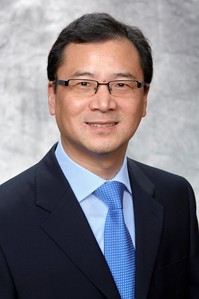学术报告通知(2020-4-28)
作者:崔新霞浏览:时间:2020-04-22
报 告 人:张丹
报告名称:可重构机器人系统及应用
报告时间:2020年4月28日上午10:00(星期二)
报告地点:腾讯会议
会 议 号:360 554 949
会议密码:12345

报告人简介:
张丹博士,于2000年6月从加拿大拉瓦尔大学(Laval University)博士毕业后,研究集中于机器人与自动化、先进制造技术以及新型高性能机器人及其应用的交叉领域,并且把高性能机器人应用于机床、医疗设备、MEMS、抛光、去毛刺等工业应用中。
主要学术贡献是并联机器人的构型创新、运动静力学建模及操作性能优化等。其设计的机器人在航空、汽车、机床、煤矿和其他特殊环境下有广泛的应用实例。他发明并制造了世界上独一无二的具有被动约束链的多轴并联机器人机床,得到同行的广泛关注和好评。该技术被誉为“二十一世纪机器人机床”。提出的铰链安装误差、丝杠执行误差和随机误差的融合模型与补偿技术,不仅在高精度三自由度并联机床上得到了有效的应用,而且在Five-hundred-meter Aperture Spherical radio Telescope (FAST) 50m模型研究中就采用了这一技术,有效提高了馈源精调平台的执行精度,实现了亚毫米级定位精度,使FAST得以“精益求精”。
指导培养博士后18人,博士研究生20人,硕士研究生26人,访问学者25人。在国际杂志发表论文187篇,国际会议论文166篇以及出版专著9部。
报告内容简介:
Robotics provides transformative technologies for all aspects of human lives from manufacturing, education, entertainment, healthcare and medical systems. Nevertheless, it is an open technology that continues to evolve for higher accuracy, speed, reliability, robustness, resilience and sustainability. In particular, the attributes of resilience and sustainability have only received growing attentions recently. Robotics is also a highly interdisciplinary technology which integrates knowledge from many fields including mechanical engineering, electronics engineering, and informatics. One of the most significant challenges this technology faces today istodevelop technologies for the new attributes (such as sustainability) of a robotic system. However, system sustainability can be achieved by reconfiguration and decentralization, whose system configurations are evolved with the changes of design requirements and dynamic environment. The modular construction of parallel robotic machines allows them to achieve this objective and generate a class of reconfigurable robotic structures.
In this talk, the parallel robotic system and its characteristics will be presented and discussed. Based on the modular structure of parallel robotic system, reconfigurable robots are generated and their potential applications such as 3D printer, machine tools and mobile modular rescue robots etc. are demonstrated.
扫一扫分享此页


